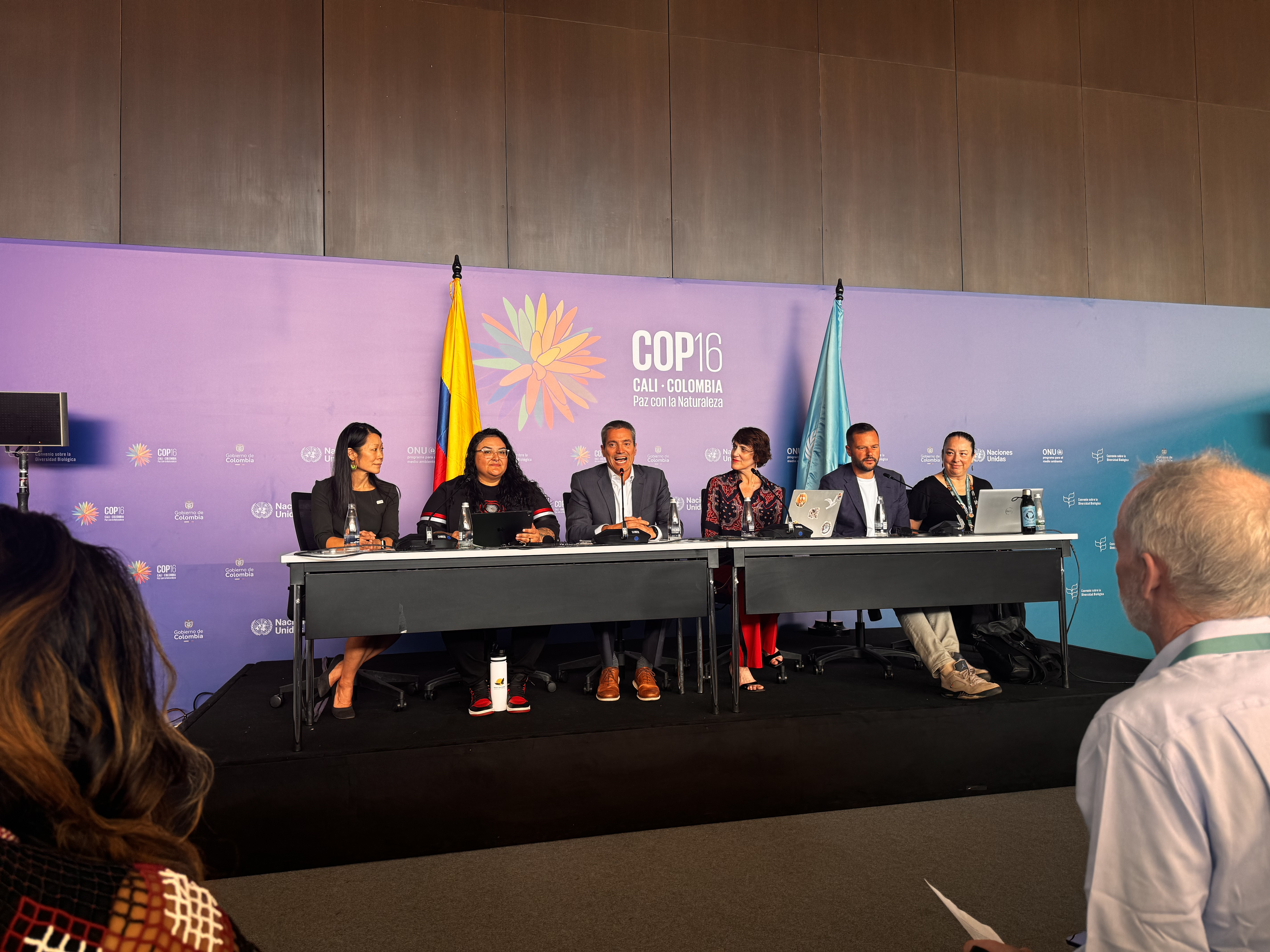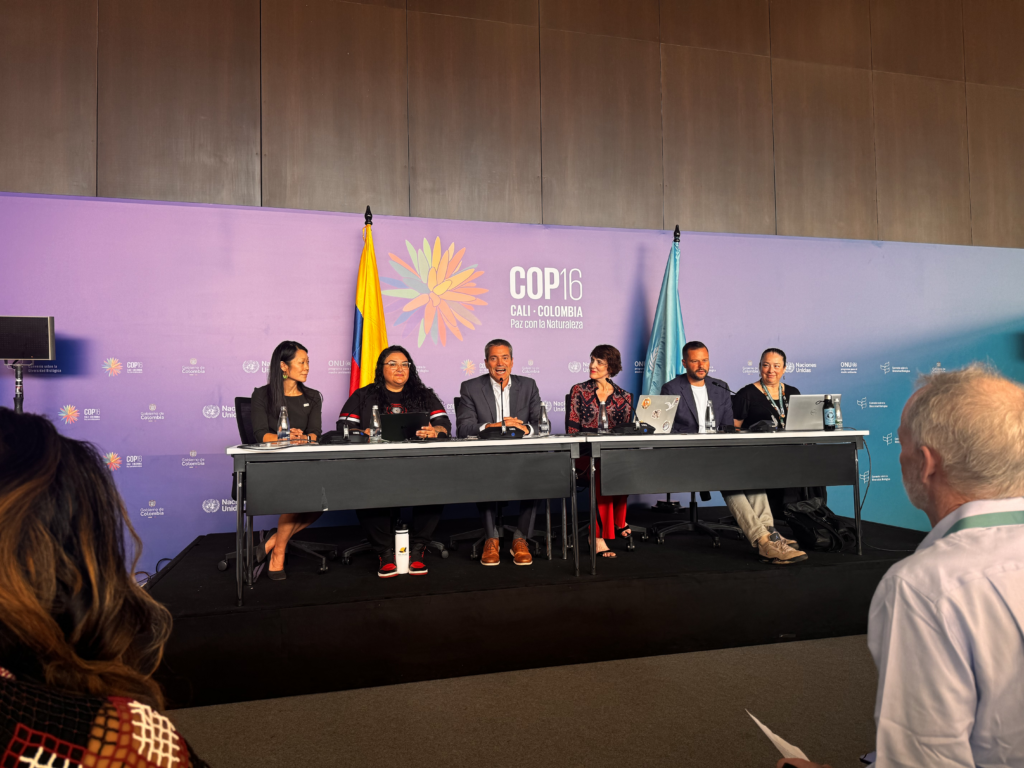
Blog
COP16 Takeaways: U.S. States Help to Rebalance Biodiversity on a Global Scale
April 7, 2025
This blog was written by Justin Gulino, NCEL’s Conservation Associate, who attended COP16 (the 16th meeting of the Conference of the Parties to the Convention on Biological Diversity) from October 23 to November 1, 2024.
Overview: State Action to Preserve Biodiversity
As the world gathered at COP16 in Cali, Colombia, to confront the biodiversity crisis, states like California stepped up to bring the American perspective to the global conservation stage. The conference included collaborative discussions around conservation policy and thought-provoking reminders of humans’ impact on the natural world, including The Biodiversity Game, a towering Jenga-like sculpture symbolizing the fragile balance of nature. This blog explores why state leadership in global conservation efforts matters more than ever in preserving nature’s delicate balance.
The Visual Warning of “The Biodiversity Game”
“The Biodiversity Game,” COP16’s premier art installation, offered one answer to why action to conserve biodiversity is crucial, making it clear that losing biodiversity threatens our children’s and grandchildren’s futures.

Designed by Benjamin Von Wong, The Biodiversity Game is a Jenga tower where each block represents different environments in the natural world, with three children perched atop. Scattered blocks on the ground show how human development, from sprawling suburbs to factory farms, has led to the decline of key ecosystems. As more blocks vanish, the tower teeters, symbolizing the growing instability of nature.
When States Lead: California at COP16
Recognizing the threat nature faces, a 100-member California delegation – including legislators, Tribal representatives, state agency officials, academics, business officials, and environmental professionals – attended the United Nations Convention on Biological Diversity’s 16th Conference of the Parties (COP16) last October to showcase American state-level conservation leadership. The California Delegation and other subnational actors were among the few American officials attending COP16, as the federal government remained largely absent from the global conservation talks.
While the Convention aims to safeguard global biodiversity for future generations, the U.S. remains the only nation, aside from the Vatican, that has not ratified the global treaty to conserve nature. Despite helping to draft the agreement in 1992 and the Clinton Administration signing on, the U.S. never secured the votes needed in the Senate to ratify the treaty into law. As a result, the U.S. holds only “observer” status, limiting its role to informal participation without influence over final decisions about the CBD’s implementation.
A Legacy of Leadership: How U.S. Conservation Laws Shaped the World
The United States’ “observer” status ultimately limits its ability to lead on global biodiversity action, despite a legacy of shaping conservation policy worldwide. The American Endangered Species Act has influenced the creation of similar acts in Canada, Australia, Ireland, the Philippines, and across the African continent. All of these nations’ statutes share a similar conservation ethos to the United States: protecting endangered species improves both the long-term wellbeing of nature and each country’s citizens.
U.S. influence is also seen in the endangered species trade laws of the United Kingdom, New Zealand, Nigeria, and Singapore, specifically in regards to implementing the Convention on the International Trade in Endangered Species of Flora and Fauna (CITES).
Conservation Alliances and Best Practices from Around the Globe
California took a leading role in highlighting recent American conservation action at COP16 with California Secretary of Natural Resources Wade Crowfoot and state legislators Sen. Limón, Assemb. Kalra, and Assemb. Haney serving as ambassadors for California’s national-leading conservation policies. These officials shared the state’s progress on biodiversity conservation with the world through panel discussions, individual meetings with fellow policymakers, and even a press conference.

COP16 offered a vital space for collaboration, with Californians joining global voices — from Indigenous leaders to academics and business experts — to educate the audience on how differing approaches can drive meaningful progress in conservation. The conference also presented the opportunity to form long-term partnerships: California now chairs the Subnational Taskforce of the High Ambition Coalition for Nature and People, launched in partnership with Quebec after the state’s 2022 attendance at COP15 in Montreal.
International partnerships are necessary when considering the scale of biodiversity loss facing every state, nation, and the planet. Over 1 million species of plants and animals are at risk of extinction within current lifetimes, being threatened primarily by habitat degradation, nature’s overexploitation, climate change, pollution, and invasive species. While some of these drivers of biodiversity loss can be addressed locally, others, such as pollution, require collaboration. COP16 officially came to a close in February 2025 with new commitments to protect biodiversity worldwide.
Key Achievements from COP16
COP16 largely sought to refine the implementation of the Global Biodiversity Framework, a roadmap established in 2022 to provide the countries and subnational units with strategies to halt and reverse biodiversity loss by 2030. Key outcomes from COP16 include:
- Adopting the action plan on biodiversity and health within the One Health Framework.
- Establishing the Cali Fund so that companies that profit off digitally accessed genetic resources can contribute funds for biodiversity conservation.
- Recognizing the role of Indigenous people in conservation and establishing a platform for their formal involvement in the Biodiversity Convention.
- Agreeing to establish a permanent funding mechanism to implement the Global Biodiversity Framework (a 30-year achievement).
- Emphasizing the need for countries to synergize their environmental work across the Biodiversity Convention and Climate Convention.
Looking Ahead to COP17
The next Biological Diversity Convention Conference is in 2026 in Armenia. While the US will likely continue to be an “observer” at the Convention, it will come down to states joining together in 2026 to protect biodiversity for generations to come.
Visit NCEL’s Biodiversity Issue Page to learn more about state-led efforts to conserve nature as well as pending legislation across the country.